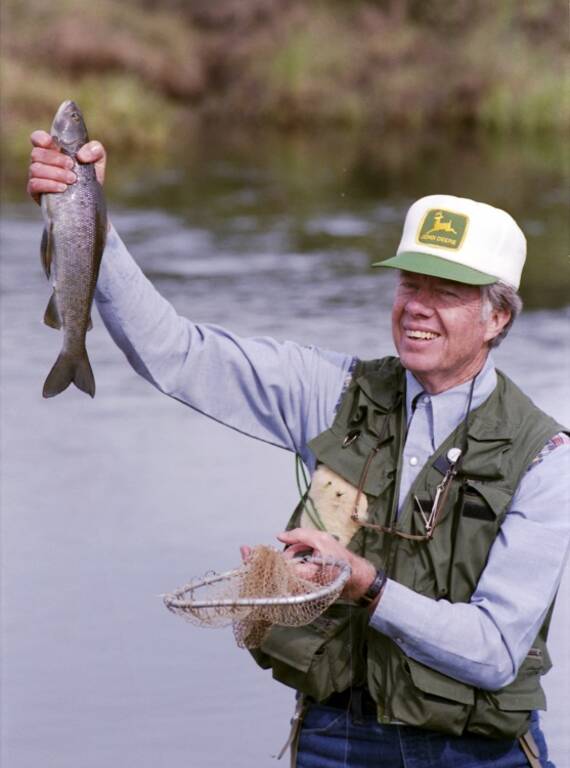NPCA’s tribute to the former U.S. president and ardent national park advocate.
In his 1988 memoir, “An Outdoor Journal,” former President of the United States Jimmy Carter wrote, “It is good to realize that if love and peace can prevail on earth, and if we can teach our children to honor nature’s gifts, the joys and beauties of the outdoors will be here forever.”
President Carter passed away yesterday, Dec. 29, at the age of 100. Our country has lost a conservation legend, one of the greatest presidents national park advocates have ever known. His dedication to public service and protection of our natural environment was matched by few of his predecessors or peers.
And yet despite his many accomplishments as a leader and diplomat, he remained the same quiet, humble son of Georgia that Americans elected to the presidency in 1977. He was a peanut farmer from a small town, through and through, and that’s what Americans loved about him. He was like so many of us. He was relatable in a way so many politicians are not.
That small-town peanut farmer worked with Congress and advocates like NPCA to protect more than 56 million acres of land in Alaska. In 1980, he signed the Alaska National Interest Lands Conservation Act (ANILCA) into law, creating 10 new national parks and preserves, including Wrangell-St. Elias, which is now our country’s largest national park.
The law also created two new national park sites, nine new national wildlife refuges, two new national conservation areas and 25 new wild and scenic rivers. President Carter had designated many of these lands as national monuments under the Antiquities Act, spurring Congress and other stakeholders to finally get long-running conversations about this legislation across the finish line. His landmark efforts to protect Alaskan wilderness doubled the land area protected by the National Park Service.

President Jimmy Carter holds up a fish he caught in Alaska’s Clarence Lake in 1980.
Courtesy: Jimmy Carter Presidential LibraryPresident Carter knew that taking bold action to protect Alaska’s vast, biodiverse wilderness and natural resources could have serious impacts on Alaska Natives. His administration worked to ensure Alaska Natives and rural communities across Alaska had relatively open access to much of the new national parks’ natural resources so that they could continue long-practiced traditional subsistence uses like hunting and fishing.
As the Park Service wrote in 2020, “In this way, the landmark law that created many of Alaska’s national park units confirms the strong connection between local residents and the land. However, the word ‘subsistence’ means more than just putting food on the table. It includes the identity, culture, customs, traditions, values and beliefs that define Alaska Native peoples.” President Carter understood that.
The best way we can honor President Carter and his boundless dedication to public service and conservation, however, is by showing up to protect our national parks today and every day.
Today, President Carter is revered by conservation leaders across the country for the impactful policies he put in place to protect the Alaskan wilderness, and rightfully so. But to me, the greatest reason to admire President Carter is for his bravery.
Protecting Alaska natural resources was the right thing to do, but that does not mean it was easy. ANILCA was a complicated plan, and it was not perfect, nor was it initially politically popular everywhere. A week after President Carter used his Antiquities Act powers to protect those 56 million acres of Alaskan wilderness, protesters in the Alaska communities of Ketchikan and Fairbanks burned effigies of the president. Protesters at Denali National Park — then called Mount McKinley — labeled a silhouette “Carter?” and used it for rifle target practice.
But President Carter was undeterred. He knew what was at stake, and he took a brave stand for some of the wildest lands in America despite threats to his safety and his political popularity. He put his country, and its unique, scenic natural wonders, above himself.
Nearly 45 years later, his decision has paid off and then some for the American people. Millions of people from around the world visit the breathtaking peaks and beautiful waters of Alaska’s national parks every year, contributing nearly $2 billion to local economies. Today, Alaska’s public lands protect complex, biodiverse ecosystems at a magnitude that is hardly seen anywhere else.
For instance, 98% of the brown bears in the United States make their homes in Alaska. In a 2014 Outside magazine article about Aniakchak National Monument and Preserve, journalist Chris Solomon recalled what he learned from Alaska Fish and Game biologist Dave Crowley: “Aniakchak bears live at the largest buffet table on earth — berries, salmon, moose. They’re so well fed they ‘tend to be fat and lazy,’ he said; he’d watched bears catch salmon and only lick them, they were so full.” Aniakchak was one of the national monuments President Carter designated in 1978.
More than 400 species are listed as threatened or endangered in the contiguous United States. In Alaska, only 20 species are listed this way. Alaska national parks provide a haven for wildlife and outdoor enthusiasts alike, and none of it would be possible if President Jimmy Carter hadn’t stood up for America’s wild north.
Carter’s national parks legacy extends beyond protections for Alaska. He signed a total of 39 national park sites into law, including ones dedicated to America’s diverse history such as Martin Luther King Jr. National Historic Site (later Historical Park) in Georgia, Boston African American National Historic Site in Massachusetts, and Women’s Rights National Historical Park in New York. He was a noted champion of urban national parks, designating the now-famous Santa Monica Mountains National Recreation Area and the Chattahoochee River National Recreation Area, both of which remain paragons of park accessibility for Americans in cities.
President Carter never stopped fighting for our public lands. At age 97, he filed a legal appeal to stop a road from cutting through Izembek National Wildlife Refuge, arguing the move would gut ANILCA. According to The New York Times, he described a visit to Arctic National Wildlife Refuge, one of the largest expanses of wilderness in the United States, as “one of the most unforgettable and humbling experiences” of his life.
In 2016, then-National Park Service Director Jonathan Jarvis declared Carter an honorary national park ranger in a special ceremony. The Park Service has made great strides in honoring his legacy at Jimmy Carter National Historical Park in his hometown of Plains, Georgia. This national park includes his boyhood home, the high school he attended with his beloved wife Rosalynn, and the humble train depot that served as his political campaign headquarters. He is certainly deserving of those honors.
The best way we can honor President Carter and his boundless dedication to public service and conservation, however, is by showing up to protect our national parks today and every day. Thanks to Alaska Native leaders and park supporters across the country, the Ambler Road, a disastrous 211-mile industrial access road that would have threatened the Western Arctic Caribou Herd, was effectively stopped by Department of the Interior Secretary Deb Haaland and President Biden in April.
This decision will need to be defended, however, in solidarity with the Alaska Native communities that depend on the Arctic caribou and fisheries for subsistence, as well as the 20 million acres of national parklands, including Gates of the Arctic National Park and Preserve, originally protected by Carter. The next time we face a looming landscape-scale threat to Alaska’s national parklands, we will be carrying on the legacy of President Jimmy Carter and his love for this wild wonderland.
The next time I go to Capitol Hill or the Oval Office to advocate for our national parks, I will have President Carter on my mind and in my heart. On behalf of the National Parks Conservation Association staff, members and supporters, I want to extend sincerest condolences to the Carter family and all who loved President Jimmy Carter. He might have thought he was just a Georgia peanut farmer coming to Washington to try to fix a few things. But to us, he was, and will always remain, an icon of conservation and public service.
Stay On Top of News
Our email newsletter shares the latest on parks.
About the author
-
 Theresa Pierno President and CEO
Theresa Pierno President and CEOTheresa Pierno is President and CEO of the National Parks Conservation Association. She joined NPCA in 2004 after a distinguished career in public service and natural resource protection, and has helped to solidify the organization's role as the voice of America's national parks.
-
General
-
- Parks:
- Aniakchak National Monument & Preserve
- Boston African American National Historic Site
- Chattahoochee River National Recreation Area
- Jimmy Carter National Historical Park
- Martin Luther King, Jr. National Historical Park
- Santa Monica Mountains National Recreation Area
- Women's Rights National Historical Park
- Wrangell St. Elias National Park & Preserve
-
-
Issues


